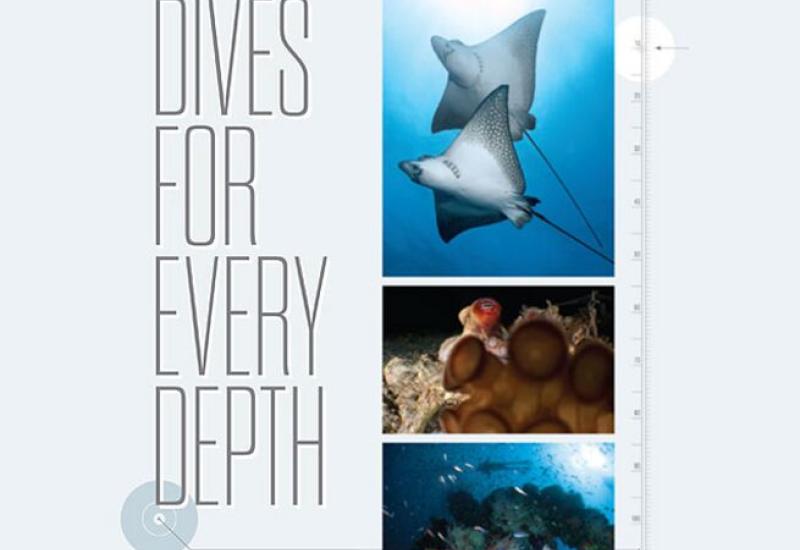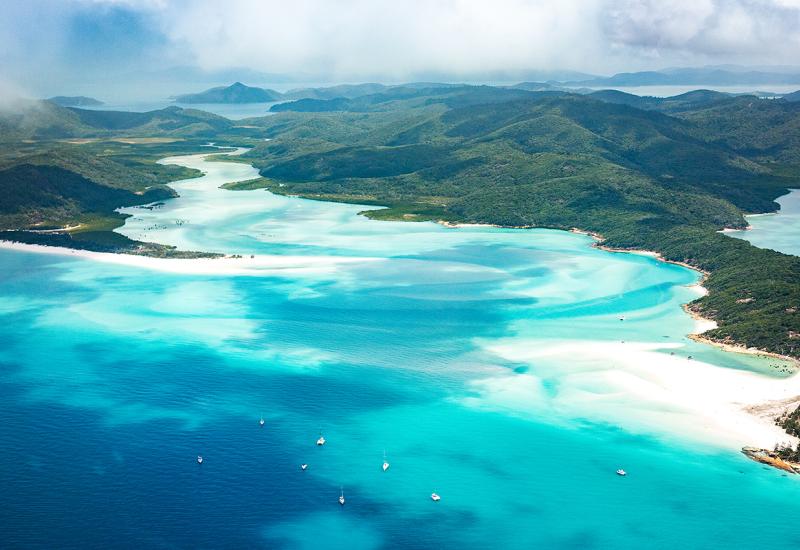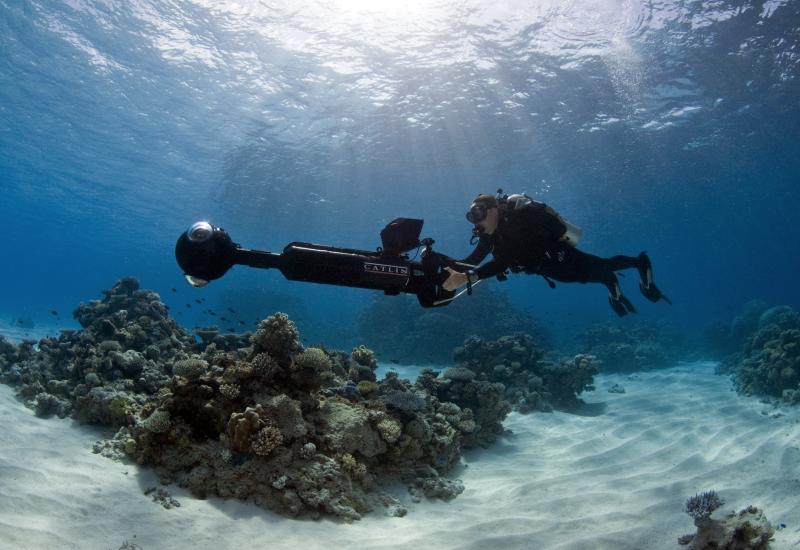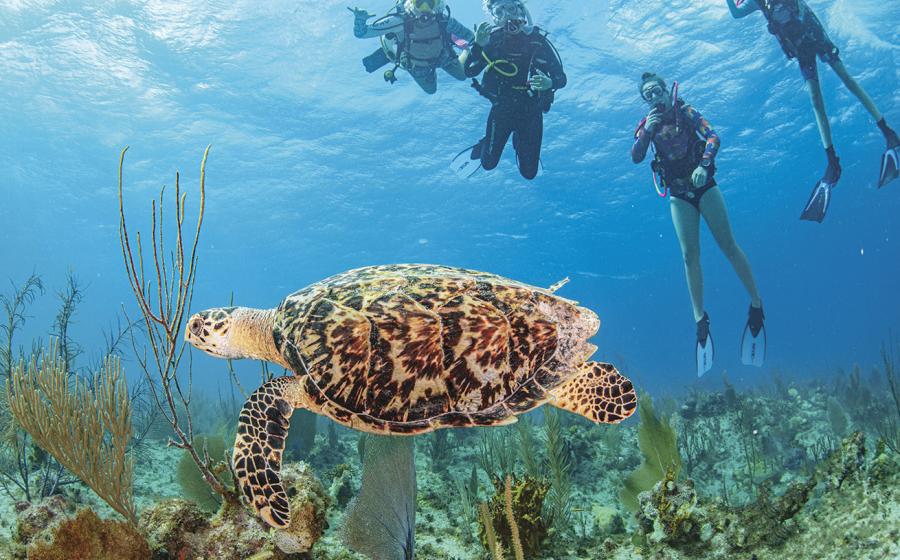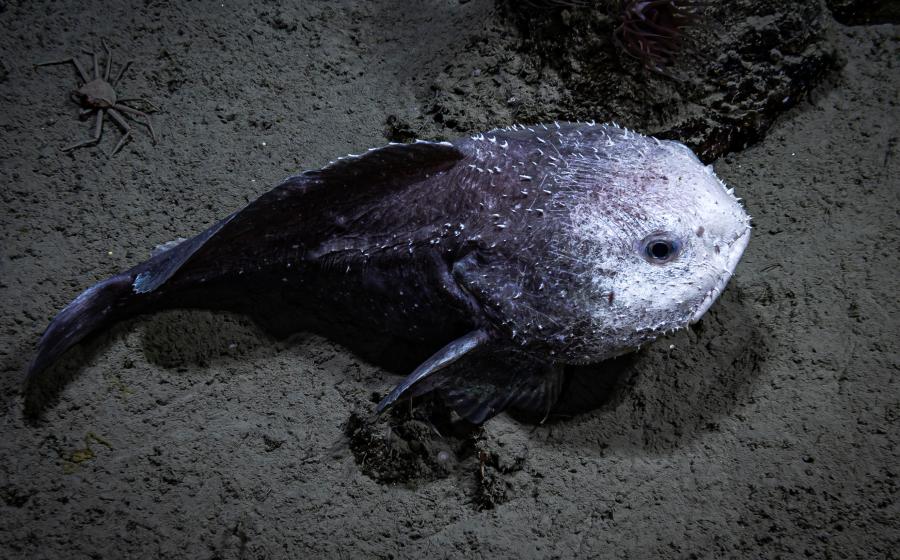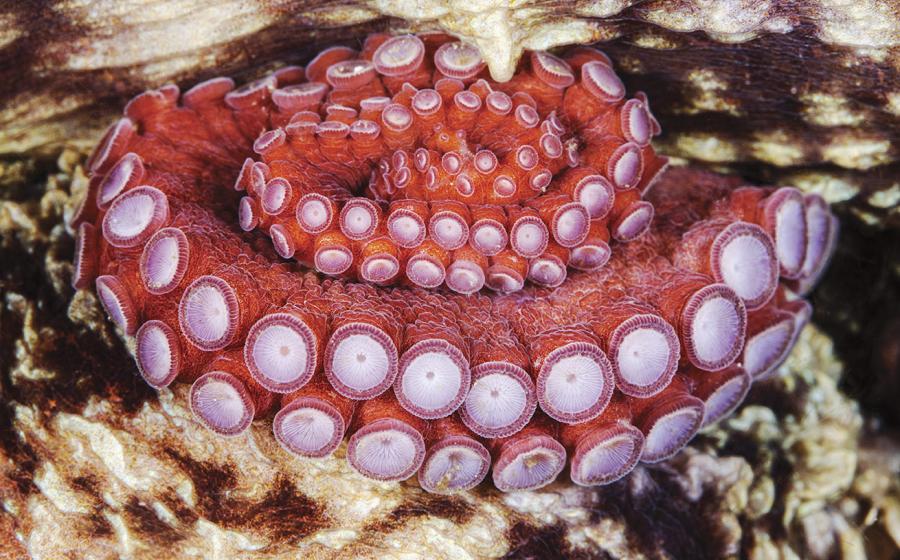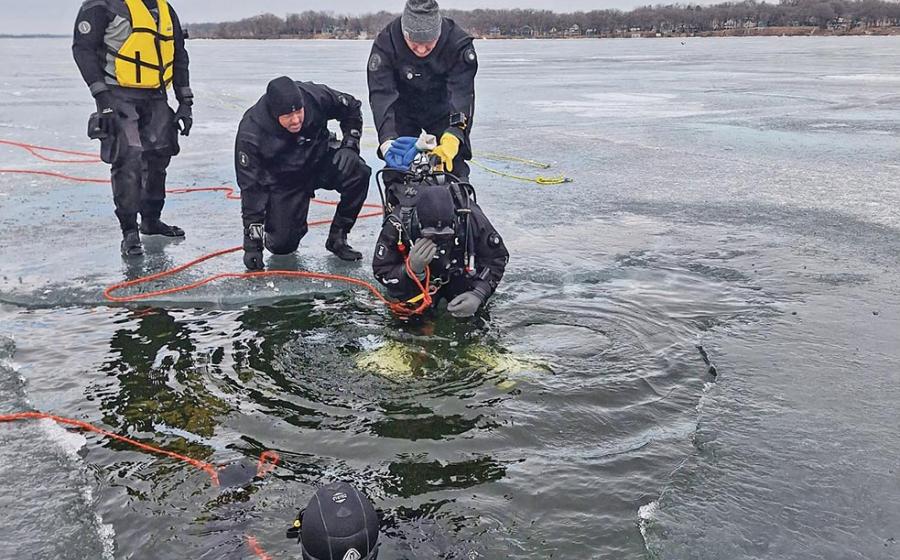An Inside Look at Diving in Tahiti

From the thrilling rush of its pass dives to the sedate island life, Tahiti offers a change of pace like no other island paradise. Plan your own trip and check out the photos in our Diver's Guide to Tahiti Diving.
I bite hard on my mouthpiece as the full current-borne mayhem emerging from the atoll’s lagoon rips the exhalations from my regulator in a chaos of bubbles. Even at 120 feet, I can clearly see the ripples on the surface of this preternaturally clear water. Sharks, ma’o, totem of the Polynesian people, are everywhere. I watch the slow sweep of tail fins suspended in the invisible current. It is a valley filled with elasmobranchs: above me, below and as far into the endless blue as I can see. Tucking knees to chest, I make myself smaller in an attempt to hide — not from the sharks, but from the unyielding current that will soon carry me away from this wondrous spectacle. Only minutes later, the other divers and I are riding that irrepressible force back into the tranquil lagoon where the first breaths above surface include primal whoops and howls to unleash the fading adrenalin. “Maeva! Manava!” shouts David Guerin, Topdive’s manager. “Welcome to Fakarava.”
The final approach of the flight from Papeete, Tahiti, to the northern reaches of the Tuamotu island group is simply too short. The view of floating turquoise discs adrift in indigo punctuated by splashes of jade and crescents of sun-bleached sand is sensory shiatsu — medicine — for those who leave Papeete’s bustle behind.
Too soon the aircraft is bouncing along the Fakarava runway. I step off the plane to hear the ubiquitous greeting, ia orana maeva (hello and welcome), and a lei of tiare flowers is placed around my neck. At this tiny airport, bare feet and flip-flops are de rigueur, and any pretense of mainland responsibility melts in the tropical sun.
The short ride down the sand road reveals how much of this place still revolves around the natural elements. Sunlight, a steady trade breeze, the coralline sand and the ever-present sea are woven into the fabric of Tahitian life. It’s sensory overload at first: Amazing fragrances hit me in waves, palm fronds dance energetically, flashes of tattooed skin the color of coconut fiber abound, women in brilliant fabrics smile broadly, and always the gentle soundtrack of the surf plays. Divers come here for the sharks, but there is also terrestrial magic at play, and the spell is all but irresistible.
Fakarava Atoll is a remarkable destination, underscored by the fact that it’s a UNESCO Biosphere Reserve. The atoll is marked by two passes through which water enters and leaves the lagoon with the incoming and outgoing tides. These passes are the lifeblood of the atoll and provide the primary diving opportunities. “Every dive has a sweet spot,” says David Guerin. “Usually it will be just before the pass opening or perhaps in a specially sheltered area.”
I had come to realize that pass diving is unlike any other drift diving I’d ever experienced. All the best action is typically near the mouth of the pass in the heaviest current, and the art is all about staying in that “sweet spot” for as long as you can (safely do so). This is not always about “going with the flow,” as many drift divers have been taught. Rather, pass diving is about dancing with the edge of the action (or finding a refuge) until air and deco time conspire to force surrender to the current.
After a few dives, my pass-diving technique has improved, and I’m rewarded at the North Pass with five varieties of shark, a manta and more schooling crescent big-eye than can possibly be imagined. The sensation is akin to what a sky diver feels when finally learning just the right amount of control and relaxation. Each day is more engaging than the one before — I’ve found my Polynesian groove and am noticing sights I’d missed before: There is an abundance of amazing and rare small tropicals that dart in the prolific hard coral while the big guys glide overhead.
Things are quiet on the motus (islands) of Fakarava. Very quiet. But this doesn’t mean divers are stuck with the latest James Patterson novel between dives. My last day on Fakarava starts with a rollicking dive through Tumakohua Pass and ends with a healthy surface interval. Guerin uses the chance to motor up to a dock on a lovely motu with a little village called Tetumanu. We gladly absorb some history of the village, home to the oldest church in the Tuamotus, which dates to the mid-1800s. As with all village visits here, we’re greeted with big smiles, barefoot kids and many flowers. I learn quickly that no one is a stranger for long in these parts.
Before heading back out, we jump into the shallows near the dock, where 20 to 30 juvenile blacktip sharks swim in concentric circles. Miniature versions of the adults, these small torpedoes are curious and yet shy. They are also quite challenging to photograph. The process isn’t made any easier when a huge Napoleon wrasse, accustomed to being fed by the villagers, shows up looking for a handout.We force ourselves back into the boat for a drop on another portion of the South Pass. “Are you ready for more sharks?” David asks. I am ready, of course, but what more does he have up his sleeve?
I shouldn’t have doubted him. At 75 feet, we enter a cave that allows our exhaled bubbles to be trapped on the ceiling, and thus seem less threatening to the wall of gray reef sharks. Other species appear as well: Adult blacktip sharks and juvenile silvertips weave in and out of the gray reefs as the cavalcade sweeps like a diorama around us.
My mind is filled with spectacular images, and the last dive seems like a perfect swan song for Fakarava. But the team has more to offer as we head ashore to a motu called Penu. A jovial Frenchman named Mathi- as and his dog, Ewa, man this remote Topdive outpost. An impromptu lunch spread is created with a few island staples: poisson cru (Tahitian raw fish in coconut milk), po’e (sticky fruit and dough mixture) and coconut bread. As we devour our meal, Mathias regales us with his little island antics and adventures. His tales of spearfishing attempts (mostly unsuccessful) and being pursued by the ocean’s “coppers” (sharks) have us howling with laughter. It takes rare people to live and work outside the confines of typical civilization, and thank goodness for that.
“I never get bored of diving here!” says Nicolas “Nico” Bernard, Topdive manager for Kia Ora Resort & Spa, on the Tuamotus’ largest atoll, Rangiroa. “Every day the current is different and brings a new experience.” Today we are going to dive Tiputa Pass, or as he likes to call it, the Rangiroa Express.
It’s impossible to describe the heavenly blues that surround the atolls. Dives almost always start there, beyond the reach of the current and where the water can be too clear to see. On this day, Bernard claims to have some special “friends” at the pass; at 30 feet he starts chirping through his regulator while simultaneously crinkling an air-filled plastic bottle. Moments later, a pod of bottle- nose dolphins appears, gracefully encircling us. The visit is brief, but inspirational, and the dive has only begun.
Diving this site requires keen attention, as divers are sucked into the pass at increasing speeds, through schools of soldierfish and barred jacks. A signal from Bernard indicates a plunge into a protected cut in the reef that provides respite from the current. This crevice creates an unexpected ringside seat for a freewheeling circus of activity. Hiding in this nook with us are schools of longfin bannerfish and snapper, all gathered tight for protection. Cruising overhead are reef sharks, eagle rays, an occasional manta and great hammerhead shark. On this day the Rangiroa Express delivers. I can’t get enough.
On our next dive we fly into Avatoru Pass, where endless fields of hard coral are packed by dense schools of bigeye jacks, and exotic African pompano shimmer in the sunlight. All the usual suspects can be found here, but the real treats are the resident silvertips. These sharks are big, girthy animals with the confident grace of an apex predator. For most of my international dive buddies, this is just another once-in-a-lifetime sighting provided by a very special corner of the South Pacific, where reality often exceeds imagination.
Life on the motus couldn’t be more different than the high adrenalin activity beneath the surface; for most, this is bucolic country living, South Pacific-style. Hine, host at Topdive — Kia Ora Resort & Spa, and unofficial ambassador to all things Polynesian, declares Rangiroa the very heart of paradise, and breaks into infectious giggles when I ask her to explain. Her raven hair is kissed by a vibrant hibiscus flower, and the intensely hued floral saronglike pareo adds legitimacy to her claim. “Life is simple here. We have everything we need, and it is always, always beautiful.”
I squint in the midday sun, past the swaying coconut palms, beyond the small restaurant suspended over the lagoon and all the way to where the reef line stands sentinel over the electric aqua of the shallows. “I can’t agree more,” I whisper back.
Evenings are spent adrift in my private pool at Kia Ora, surrounded by the natural elegance of wood and stone, and sheltered by a canopy of palm silhouettes and stars from the southern hemisphere. Though more refined than what greeted Polynesia’s earliest Western visitors, the appeal of Polynesia must have been as over- whelming then as it is now. Paradise can be fleeting, but here are places where it thrives.
My final afternoon is spent with toes buried in the white powder of a deserted beach facing the great Pacific. On this island, discovery is just a short bike ride away, so with an ice-cold Hinano in hand, I ponder my options. I’d already made several new friends and a few purchases on my ride over to the beach. Perhaps now I’ll peddle over to Tiputa Pass and watch as wild dolphins frolic in the current. Or maybe just let my imagination run with these new images for a few final hours on my personal beach. I give up trying to devise my next move. I’m just happy knowing I’ve finally found paradise.
A very special thanks to Tahiti Tourism, Air Tahiti Nui, Kia Ora Resort & Spa, and Topdive — Bathys for introducing me to their little slice of paradise.
Plan your own trip and check out the photos in our Diver's Guide to Tahiti Diving.
_ _

